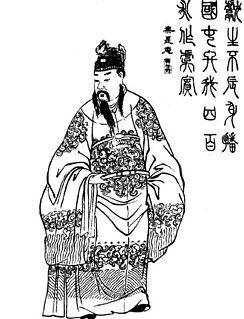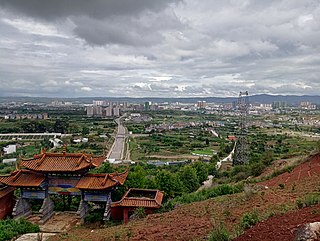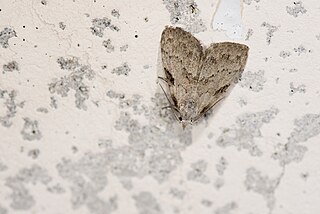
Cao Cao, courtesy name Mengde, was a Chinese warlord, statesman and poet. He was the penultimate grand chancellor of the Eastern Han dynasty who rose to great power in the final years of the dynasty. As one of the central figures of the Three Kingdoms period, he laid the foundations for what was to become the state of Cao Wei and ultimately the Jin dynasty, and was posthumously honoured as "Emperor Wu of Wei" although he never was an emperor during his life time. He remains a controversial historical figure, and is often portrayed as a cruel and merciless tyrant in subsequent literature; however, he has also been praised as a brilliant ruler and military genius with unrivalled charisma who treated his subordinates like his family.

Emperor Xian of Han, personal name Liu Xie (劉協), courtesy name Bohe, was the 14th and last emperor of the Eastern Han dynasty in China. He reigned from 28 September 189 until 11 December 220.
Chunyu Qiong, courtesy name Zhongjian, was a military officer serving under the warlord Yuan Shao during the late Eastern Han dynasty of China. He played a significant part in the Battle of Guandu in 200.
Li Ru, courtesy name Wenyou, was an official serving under the warlord Dong Zhuo during the Eastern Han dynasty of China.

The end of the Han dynasty refers to the period of Chinese history from 189 to 220 AD, which roughly coincides with the tumultuous reign of the Han dynasty's last ruler, Emperor Xian. During this period, the country was thrown into turmoil by the Yellow Turban Rebellion (184–205). Meanwhile, the Han Empire's institutions were destroyed by the warlord Dong Zhuo, and fractured into regional regimes ruled by various warlords, some of whom were nobles and officials of the Han imperial court. Eventually, one of those warlords, Cao Cao, was able to gradually reunify the empire, ostensibly under Emperor Xian's rule, but the empire was actually controlled by Cao Cao himself.
In human population genetics, haplogroups define the major lineages of direct paternal (male) lines back to a shared common ancestor in Africa. Haplogroup O-M122 is an Eastern Eurasian Y-chromosome haplogroup. The lineage ranges across Southeast Asia and East Asia, where it dominates the paternal lineages with extremely high frequencies. It is also significantly present in Central Asia, especially among the Naiman tribe of Kazakhs.
Guo Tu, courtesy name Gongze, was an official and adviser serving under the warlords Yuan Shao and Yuan Tan during the late Eastern Han dynasty of China.
Shao Kang was the sixth king of the Xia dynasty of ancient China. He was the son of Xiang. His father was killed in a battle against Han Zhuo's two sons, Han Jiao and Han Yi; Shao Kang's mother Ji managed to escape and had him after a few months. After he grew up, Shao Kang and his followers engaged in a battle against Han Zhuo, defeated and killed him, and restored the Xia Dynasty.
Shen Pei, courtesy name Zhengnan, was an official serving under the warlord Yuan Shao during the late Eastern Han dynasty of China. Xun Yu, an official serving under Yuan Shao's rival Cao Cao, once said that Shen Pei was "strong of will but without tact".

Romance of the Three Kingdoms is a Chinese television series adapted from the classical 14th century novel of the same title by Luo Guanzhong. The series was produced by China Central Television (CCTV) and was first aired on the network in 1994. It spanned a total of 84 episodes, each approximately 45 minutes long. One of the most expensive television series produced at the time, the project was completed over four years and involved over 400,000 cast and crew members, including divisions of the People's Liberation Army from the Beijing, Nanjing and Chengdu military regions. Some of the dialogues spoken by characters were adapted directly from the novel. Extensive battle scenes, such as the battles of Guandu, Red Cliffs and Xiaoting, were also live-acted.

The existence of elephants in ancient China is attested both by archaeological evidence and by depictions in Chinese artwork. Long thought to belong to an extinct subspecies of the Asian elephant named Elephas maximus rubridens, they lived in Central and Southern China before the 14th century BC. They once occurred as far north as Anyang, Henan in Northern China. The elephant is mentioned in the earliest received texts, including the Shijing, Liji, and Zuozhuan. The oracle bone script and bronzeware script glyphs for elephant are pictographic depictions of an animal with a long trunk. Their modern descendant is the regular script character 象.
Bugan, Bogan, Pakan, or Bugeng is an Austroasiatic language. The existence of the Bugan language was not known by the rest of world until recently. There are about 3000 speakers, mostly in some villages in southern Guangnan (广南) and northern Xichou (西畴), Yunnan Province, China. Bugan is an analytic language, and word order and auxiliary words have important functions in the grammar.

Three Kingdoms is a 2010 Chinese television series based on the events in the late Eastern Han dynasty and the Three Kingdoms period. The plot is adapted from the 14th century historical novel Romance of the Three Kingdoms and other stories about the Three Kingdoms period. Directed by Gao Xixi, the series had a budget of over 160 million RMB and took five years of pre-production work. Shooting of the series commenced in October 2008, and it was released in China in May 2010.

Shilin Yi Autonomous County is an autonomous county, under the jurisdiction of Kunming, the capital of Yunnan province, China.

Manoba is a genus of moths in the family Nolidae. The genus was first described by Francis Walker in 1863.
Gao Gan, courtesy name Yuancai, was a minor warlord who lived during the late Eastern Han dynasty of China. He was a maternal nephew and subordinate of the warlord Yuan Shao.
Zhang Yang, courtesy name Zhishu, was an official and minor warlord who lived during the late Eastern Han dynasty of China. Originally from Yunzhong Commandery in the north, he eventually became the de facto ruler of Henei Commandery. Although threatened by powerful warlords such as Cao Cao and Yuan Shao, Zhang Yang still provided refuge for Emperor Xian of Han numerous times, eventually attaining the rank of Grand Marshal (大司馬).
Manoba subtribei is a moth in the family Nolidae. It was described by Hui-Lin Han and Cheng-De Li in 2008. It is found in Yunnan, China.

Swords of Legends is a 2014 Chinese television series based on the role-playing video game Gu Jian Qi Tan developed by Shanghai Aurogon. It aired on Hunan TV from 2 July to 25 September 2014.
Jizhao is an unclassified Kra-Dai language spoken in Jizhao Village 吉兆村, Tanba Town 覃巴镇, Wuchuan, Guangdong. It may be most closely related to Be. In Wuchuan, Jizhao is locally referred to as Haihua 海话, which is the term used elsewhere in Leizhou 雷州, Xuwen 徐闻, and Maoming 茂名 to refer to the local Minnan Chinese dialect of Leizhou. The speakers are being subsumed under "Han Chinese" nationality in census








